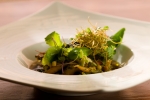Technique: Homemade Fregola

 Antoinette Bruno
Antoinette BrunoRecipe
Photos
Chef Jeremy Fox’s outside-the-box, vegetable-only fare isn’t the only element of surprise at his Napa, CA, restaurant, Ubuntu—his innovative grain applications also urge diners to push their palates’ comfort zones. In fact, it’s this culinary fearlessness that contributed to Fox’s naming as one of our Napa Sonoma Rising Stars.
In line with this philosophy, Fox serves his homemade fregola as a tasty alternative to traditional pasta; its toasted, nutty flavor is an unexpected compliment to hearty vegetable dishes, while its small size makes fregola a great substitute for couscous in summer salads.
Although the fregola technique seems simple—mix flour and water together—the devil is truly in the details. Too much water will lead to a mushy dough that can’t be properly shaped into tiny pellets.
“The real enemy of this is too much moisture,” explains Ubuntu Chef de Cuisine Marty Cattaneo, who demonstrates Fox’s homemade fregola technique in the video featured below. “Then the pasta comes out and it’s too sticky and can’t be properly shaped. It sticks together.”
Cattaneo keeps his fregola dough on the drier side by slowly incorporating the water little by little, stopping midway through to test the dough’s moisture and flavor. Once the pasta is made, Cattaneo evenly toasts the pellets to give them the wheaty, roasted flavor fregola is known for.
Step 1: Add 24 ounces durum flour, 8 ounces all purpose flour and 2 to 3 pinches salt to a pasta extruder.
Step 2: Turn on the extruder and slowly pour 13 ounces water into the dough as it mixes, stopping after 2 minutes to check the dough’s moisture and flavor. Season with additional salt as necessary.
Step 3: Slowly pour in the rest of the water, stopping once the dough begins to come together and is still on the dry side.
Step 4: Set the pasta cutter on high speed so that tiny pellets are extruded from the machine.
Step 5: Once all of the fregola is extruded, evenly toast the pellets in a pot with olive oil until golden brown.









